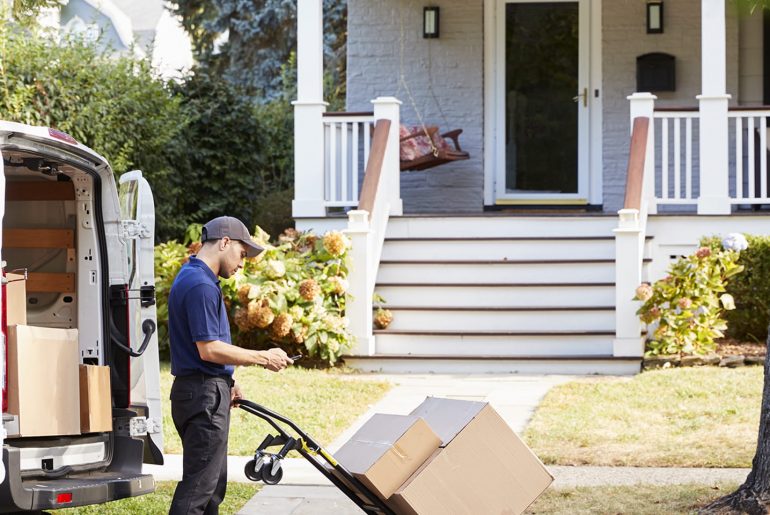Residential delivery is a costly endeavor for merchants, all thanks to last mile logistics.
While you probably don’t need to be told twice, here’s a friendly reminder: ecommerce is here to stay. Last year alone, sales hit an all time high topping off at $861 billion total in the U.S., a 44% increase compared to 2019. Unsurprisingly, a majority of these sales came from your every day consumer, with packages primarily being sent via residential delivery.
Think back to just two years ago: how comfortable were you buying gym equipment, furniture, hardware, appliances and groceries online? If you’re like many people, you were probably pretty hesitant. But things have changed. Shoppers appreciate convenience over everything else. Which means you, the retailer, need to ensure all residential deliveries arrive as expected.
In order for your residential delivery experience to be smooth sailing, there are a few things you need to understand first. And a lot of it has to do with your pre-purchase shipping strategy. In this article, we will go over the basics of residential delivery. Plus, what you can do to avoid these delivery charges altogether you can improve your shipping margins for the long haul.
What Is Residential Delivery?

Unlike commercial deliveries, residential deliveries are sent to a home address. This can be an apartment, condo, single family home. Basically, if someone lives there, it’s considered a residential address. With residential freight delivery, the experience is the same with shipments being delivered to a customer’s residence curbside or directly to the doorstep.
As an retailer, you may have noticed that the shipping fees you are invoiced from a carrier vary depending on the type of address a customer is using. You have probably asked yourself:
Why does FedEx charge more for residential delivery? Why does UPS? Why does USPS?
To put it plainly, online orders going to residential addresses are higher than those going to another place of business. Why is this the case?
The reason residential deliveries cost more? Last mile logistics.
Whether you ship orders via a small package or LTL carrier, you will be charged a residential fee. This fee applies to all shipments that are picked up or delivered to a residence.
Last Mile Delivery Fees, Explained
Most commonly used shipping carriers add a last mile delivery surcharge when delivering to residential addresses.
Last-mile delivery refers to the cost of delivering a parcel over the last leg of it’s journey to the customer. Generally, a package travels from a facility or distribution center to the customer’s preferred delivery address.
This last mile fee is the main reason why shipping costs can add up.
According to a report from McKinsey & Company, last mile delivery services make up nearly 50% of a parcel’s total delivery price for small packages.
Carriers like UPS who compete on price and delivery options have a vested interest in mitigating the costs associated with last mile delivery.
For Further Reading
- UPS 2021 Accessorial Charges (includes residential surcharges)
- FedEx 2021 Accessorial Charges (includes residential surcharges)
What Factors Influence Residential Delivery Costs?
There are a few major reasons why delivery to residential addresses is more costly. For one, these addresses are typically more spread out and have additional overhead costs. Plus, it takes more time, consumes more gas and does more wear and tear on vehicles.
Carriers may also have to perform services like address correction for residential addresses. This also adds time and administrative costs to the delivery.
Additionally, for large or bulky items that require LTL shipping, your carrier will likely use dry vans or larger trucks. These vehicles tend to be difficult to maneuver around on residential streets.
In this case, there will be two separate fees invoiced to you: A residential pickup charge and a residential delivery charge. This delivery fees can fluctuate depending on which freight carrier you work with. Therefore, it’s important to know this information beforehand via the Bill of Lading used at pickup.

What About Commercial Delivery?

On the other hand, commercial addresses are a carrier’s dream. Commercial deliveries occur at other businesses, which are typically located in highly-dense areas.
This allows a logistics provider to bundle many deliveries in a small geographic area.
Carriers may even be able to deliver multiple packages to the same address. And if not, they are probably at least delivering to other businesses nearby.
It’s this “delivery density” that drives carrier costs down.
There’s also usually someone available to receive or sign for the package when delivering commercial. Carriers likely can deliver on the first attempt and won’t have to return the package to a hub.
Can You Avoid Residential Delivery Fees?
As an ecommerce merchant, you are likely paying a residential surcharge every time your customer has a shipment delivered to their residence.
Here are a few ways you can avoid this:
Integrate Alternative Pickup Carriers
Retailers that participate in the UPS Access Point® or FedEx Hold at Location program give their customers access to conveniently located and secure pickup locations at local retail stores. These services often offer later pickup hours, and help you avoid paying or passing along a residential surcharge to your customers.
Incentivize the Customer to Enter a Business Address.
Offer your customers a discount or faster shipping if they enter a business address instead of a residential address.
Ask the Carrier to Waive the Fee During Your Annual Negotiation
Go in armed with your shipping costs. If you are a loyal customer who uses one carrier for all your small package deliveries, they may waive this fee in order to retain your business.
Work with ShipperHQ to Confirm a Customer’s Address Type

Shipping software like ShipperHQ can make sure you get charged the correct last mile fees by automatically determining whether a customer’s address is residential or commercial before an order goes out for delivery. That’s exactly why homemade cowboy boot retailer Tecovas utilizes this feature.
Thanks to ShipperHQ, the Texas boot maker gets invoiced for last-mile delivery correctly. They are able to avoid invalid addressing charges. Plus, can prevent orders from going to incorrect locations. It’s a win-win.
We spent some time doing manual address validation before, but knew a third-party Shopify app like ShipperHQ could do it a lot better than us and give us valuable ROI.
Noah Soloman, Digital Director at Tecovas
Wrapping Up
The bottom line? You could be losing out on potential savings if you don’t apply any of the tips. The reality is, these little residential delivery fees can add up. So if you are looking for a new way to improve your shipping margins, making sure your customer’s address information is correct is worth the investment.
Want to See Address Validation in Action? Sign up for a free 30 day trial of ShipperHQ today.






